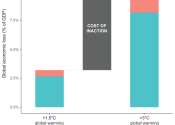Climate encompasses the statistics of temperature, humidity, atmospheric pressure, wind, rainfall, atmospheric particle count and numerous other meteorological elements in a given region over long periods of time. Climate can be contrasted to weather, which is the present condition of these same elements over periods up to two weeks.
The climate of a location is affected by its latitude, terrain, altitude, ice or snow cover, as well as nearby water bodies and their currents. Climates can be classified according to the average and typical ranges of different variables, most commonly temperature and rainfall. The most commonly used classification scheme is the one originally developed by Wladimir Köppen. The Thornthwaite system, in use since 1948, incorporates evapotranspiration in addition to temperature and precipitation information and is used in studying animal species diversity and potential impacts of climate changes. The Bergeron and Spatial Synoptic Classification systems focus on the origin of air masses defining the climate for certain areas.
Paleoclimatology is the study and description of ancient climates. Since direct observations of climate are not available before the 19th century, paleoclimates are inferred from proxy variables that include non-biotic evidence such as sediments found in lake beds and ice cores, and biotic evidence such as tree rings and coral. Climate models are mathematical models of past, present and future climates.









